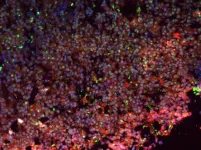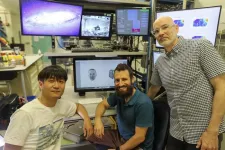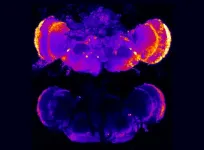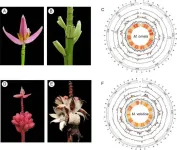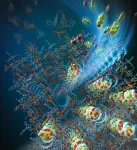(Press-News.org) Researchers at Baylor College of Medicine, the University of Cambridge and collaborating institutions have discovered that alterations in the human gene TRPC5 cause obesity and postpartum depression.
Taken together, their studies in cells, animal models and humans showed that TRPC5 acts on distinct neuronal populations in the hypothalamus, a brain region that regulates multiple innate behaviors including feeding, anxiety, socialization and maternal care. The findings, published in the journal Cell, identify TRPC5 as a diagnostic marker of obesity and postpartum depression as well as potential therapeutic strategies to treat these conditions.
“Our investigation into the role of TRPC5 in obesity and postpartum depression began with the finding that the X chromosomes of two unrelated boys with intense food-seeking behavior, severe obesity and other altered behaviors were missing a small piece that included this gene,” said co-corresponding author Dr. Sadaf Farooqi, professor of metabolism and medicine at the University of Cambridge. “Their mothers had obesity, anxiety and postpartum depression. We found that they were carriers – one of their two X chromosomes was missing the TRPC5 gene.”
Obesity and postpartum depression are significant global health problems. According to the World Health Organization, obesity has more than doubled in adults since 1990, and quadrupled in adolescents. Postpartum depression occurs in 10 to 15% of mothers and is associated with significant maternal health problems. Globally, postpartum depression remains a major cause of death by suicide in women at a time when maternal mortality due to infections and hemorrhage has declined.
The brain connection
“Previous studies had shown that disrupting gene Trpc5 in the brain causes obesity due to increased food intake and reduced energy expenditure in mice,” said co-corresponding author Dr. Yong Xu, professor of pediatrics – nutrition and associate director for basic sciences at the USDA/ARS Children’s Nutrition Research Center at Baylor College of Medicine.
In the current study, the Xu lab and the Farooqi lab collaborated to investigate the role of TRPC5 in obesity and postpartum depression. By combining the individual expertise of each lab – basic and genetic animal studies in the Xu lab and human genetics and clinical studies in the Farooqi lab – the team was able to show that TRPC5 is an important regulator of obesity, postpartum depression and other human behaviors.
To investigate the mechanisms underlying the characteristics observed in people with a defective TRPC5 gene, the researchers generated a mouse model that carries a defective variant of this human gene. Male mice with this mutation gained weight on a high-fat diet and showed anxiety, increased arousal and reduced sociability. Female mice carrying the mutation exhibited depression-like behavior after giving birth and impaired maternal-offspring interactions. Intriguingly, virgin female mice carrying the mutation did not show depression-like behavior.
“These studies show that the characteristics and behaviors seen in humans with a defective TRPC5 gene were also present in our mouse model and establish that TRPC5 regulates a spectrum of innate behaviors across mammalian species,” Xu said.
Digging deeper into the mechanisms mediating the actions of this gene, the researchers found that the gene’s actions seem to involve at least two different types of brain cells, Pomc neurons and oxytocin neurons, both in the hypothalamus.
Pomc neurons in the arcuate nucleus of the hypothalamus help regulate body weight by reducing food intake, and about 90% of these cells express Trpc5. The team discovered that genetic disruption of Trpc5 impaired the ability of Pomc neurons to reduce appetite in mice.
The team also discovered high levels of Trpc5 expression in oxytocin neurons in the paraventricular nucleus of the hypothalamus (PVH) in mice. This specific group of neurons in the brain is known to regulate energy balance in the body and the response to stress, emotion and social behaviors including mother-infant bonding.
“Removing the Trpc5 gene from PVH oxytocin neurons in mice caused severe overeating and obesity in both sexes and postpartum depressive behavior and reduced maternal care in females,” Xu said. “On the other hand, overexpressing the functional gene in the neurons of mice carrying a defective gene improved these conditions. Together, the results show that these genetically encoded innate maternal behaviors are mediated by Trpc5 on oxytocin neurons.”
“Our findings not only provide a better understanding of the genetic basis and neural mechanisms involved in obesity and postpartum depression but also have direct clinical implications by advancing the diagnostic practice of these two different human diseases,” Farooqi said. “Our work supports screening for TRPC5 to provide a clinical diagnosis for these conditions.”
In addition, the discovery of the key role TRPC5 plays in these conditions suggests that strategies directed at this protein can potentially lead to new treatments. The authors propose that as overeating and obesity of TRPC5 deficiency is mediated by impaired activation of Pomc neurons, this disorder may be treatable with an MC4R agonist drug licensed for the treatment of genetic obesity syndromes. Oxytocin receptor agonists or gene therapy to restore TRPC5 expression in specific areas of the hypothalamus are potential therapeutic strategies for people with postpartum depression.
Other contributors to this work include Yongxiang Li, Tessa M. Cacciottolo, Na Yin, Yang He, Hesong Liu, Hailan Liu, Yuxue Yang, Elana Henning, Julia M. Keogh, Katherine Lawler, Edson Mendes de Oliveira, Eugene J. Gardner, Katherine A. Kentistou, Panayiotis Laouris, Rebecca Bounds, Ken K. Ong, John R. B. Perry, Inês Barroso, Longlong Tu, Jonathan C. Bean, Meng Yu, Kristine M. Conde, Mengjie Wang, Olivia Ginnard, Xing Fang, Lydia Tong, Junying Han, Tia Darwich, Kevin W. Williams, Yongjie Yang, Chunmei Wang, Shelagh Joss and Helen V. Firth. The authors are affiliated with one or more of the following institutions: Baylor College of Medicine, University of Cambridge, Wellcome-MRC Institute of Metabolic Science, NIHR Cambridge Biomedical Research Center, Exeter Center of Excellence for Diabetes Research, University of Exeter Medical School, University of Texas Southwestern Medical Center at Dallas, Queen Elizabeth University Hospital at Glasgow, Cambridge University Hospitals NHS Foundation Trust and Wellcome Sanger Institute.
This work was supported by a Wellcome Principal Research Fellowship (207462/Z/17/Z), National Institute for Health and Care Research Cambridge Biomedical Research Centre, Botnar Fondation, Bernard Wolfe Health Neuroscience Endowment and an NIHR Senior Investigator Award. Funding for the DECIPHER project was provided by Wellcome. Additional funding was provided by National Institutes of Health grants (T32HD098068, R01 DK119169 and P01 DK119130-03), USDA/ARS (51000-064-01S), American Heart Association Fellowships 20POST35120600, 2020AHA000POST000204188, 23POST1030526 and 23POST1030352, American Diabetes Association Fellowship (1-24-PDF-56), NIHR Clinical Lectureship CL-2019-14-001, Wellcome Transforming Genetic Medicine Initiative grant (WT200990/A/16/Z), Research England “Expanding Excellence in England” award and National Institute for Health and Care Research Exeter Biomedical Research Center and Medical Research Council Unit programs MC_UU_12015/2, MC_UU_00006/2.
###
END
Alterations in human gene TRPC5 cause obesity and postpartum depression
2024-07-02
ELSE PRESS RELEASES FROM THIS DATE:
In-hospital delirium and disability and cognitive impairment after COVID-19 hospitalization
2024-07-02
About The Study: In this cohort study of 311 hospitalized older adults with COVID-19, in-hospital delirium was associated with increased functional disability and cognitive impairment over the 6 months following discharge. Older survivors of a COVID-19 hospitalization who experience in-hospital delirium should be assessed for disability and cognitive impairment during postdischarge follow-up.
Corresponding author: To contact the corresponding author, Lauren E. Ferrante, M.D., M.H.S., email lauren.ferrante@yale.edu.
To access the embargoed study: Visit our For The Media website at this link https://media.jamanetwork.com/
(doi: 10.1001/jamanetworkopen.2024.19640)
Editor’s ...
E-cigarette use and lung cancer screening uptake
2024-07-02
About The Study: In this cross-sectional study, e-cigarette use was independently associated with lower use of lung cancer screening, particularly among individuals who had quit smoking combustible cigarettes. Emerging research suggests that e-cigarettes contain definite and probable carcinogens and cause similar cancer-associated gene deregulations as combustible tobacco.
Corresponding author: To contact the corresponding author, Qian Wang, M.D., M.P.H., email qian.wang@uhhospitals.org.
To access the embargoed study: Visit our For The Media website at this link https://media.jamanetwork.com/
(doi: ...
A study led by UPF describes how insulinomas, a rare type of pancreatic beta cell tumor, form
2024-07-02
An experimental study led by Pompeu Fabra University describes the mechanism whereby insulinomas, a rare type of neuroendocrine tumour that affects pancreatic beta cells. According to the study, insulinomas are the result of the accumulation of rare mutations that lead to a homogeneous change in the epigenetic profile of pancreatic beta cells. This profile change causes beta cells to express unusually high levels of oncogenes, growth and transcription factors, and genes related to insulin production.
Insulinomas are rare pancreatic neuroendocrine tumours that involve the excessive growth of beta cells, which are responsible for secreting insulin. Often, they are diagnosed ...
NIH researchers discover a new face-detecting brain circuit
2024-07-02
Scientists at the National Institutes of Health (NIH) have uncovered a brain circuit in primates that rapidly detects faces. The findings help not only explain how primates sense and recognize faces, but could also have implications for understanding conditions such as autism, where face detection and recognition are often impaired from early childhood. The newly discovered circuit first engages an evolutionarily ancient part of the brain called the superior colliculus, which can then trigger the eyes and head to turn for a better look. This better view enables different brain areas in the temporal cortex to engage ...
Potential new target for early treatment of Alzheimer's disease
2024-07-02
UNIVERSITY PARK, Pa. — A class of proteins that regulates cell repair and enhances cell growth-signaling systems could be a promising new target for the treatment of Alzheimer's and other neurodegenerative diseases, according to a new study led by researchers at Penn State. They found that disrupting necessary sugar modifications of these proteins promotes cell repair and reverses cellular abnormalities that occur in neurodegenerative diseases.
The study appeared today (July 2) in the journal iScience, and the researchers have a patent related to this work.
“Strategies ...
Subnormal serum liver enzyme levels
2024-07-02
Liver diseases are commonly diagnosed using serum enzyme assays, particularly for aspartate aminotransferase (AST), alanine aminotransferase (ALT), alkaline phosphatase (ALP), gamma-glutamyl transpeptidase (GGT), and 5'-nucleotidase (5'-NT). While elevated levels of these enzymes are typically associated with liver and bile duct injuries, subnormal levels can also indicate various pathologies. This review consolidates current knowledge on diseases linked with subnormal liver enzyme levels, focusing on their pathogenesis, specificity, and treatment ...
Too much treadmill? This could help your shin splints
2024-07-02
Good news for all the treadmill runners who suffer from stubborn and painful shin splints: A little outdoor gait training may help, new research suggests.
A randomized controlled trial found that four weeks of gait training outdoors, in addition to home exercises often prescribed for shin splints, led to improved running biomechanics even when the runners were using a treadmill. These improvements included decreasing the time the runners’ feet were in contact with the ground or treadmill, a recently identified contributor to shin splints.
Based on the trial results, ...
Journal of Participatory Medicine announces new theme issue on Patient and Consumer Use of Artificial Intelligence for Health
2024-07-02
(Toronto, July 2, 2024) JMIR Publications invites submissions to a new theme issue titled “Patient and Consumer Use of Artificial Intelligence for Health” in its premier open access journal Journal of Participatory Medicine indexed in PubMed, SCOPUS, Sherpa Romeo, and DOAJ.
This theme issue will explore the use of AI for health (AIH) from the perspectives of patients and the public. The journal is seeking papers that examine (a) the experience and impact of patients and health consumers using AI applications, and (b) the involvement of patients, caregivers, and the public in the co-design and development of AIH.
For this theme issue, the journal ...
Unveiling the genetic secrets of Musa ornata and Musa velutina: insights into pericarp dehiscence and anthocyanin biosynthesis
2024-07-02
In a pioneering study, researchers have completed the chromosome-level genome assemblies for Musa ornata and Musa velutina, shedding light on the genetic underpinnings of pericarp dehiscence and anthocyanin biosynthesis in bananas. This genetic blueprint is poised to revolutionize the enhancement of bananas' ornamental appeal and nutritional quality, unlocking mysteries that were previously obscured by limited genomic data.
Musa ornata and Musa velutina, known for their ornamental appeal, face cultivation challenges ...
Researchers achieve dual-functional supramolecular materials
2024-07-02
Versatile molecular frameworks called discrete supramolecular structures act like microscopic building blocks customizable for a wide variety of applications. The structures can serve in drug delivery, provide unique environments for catalytic reactions or plug into a molecular machine.
In their paper published June 25 in the Journal of the American Chemical Society, researchers from Yokohama National University presented a new methodology to advance self-assembly of dual-functional supramolecular materials.
Self-assembly involves the spontaneous generation of a well-defined, discrete supramolecular architecture from ...
